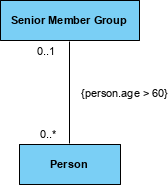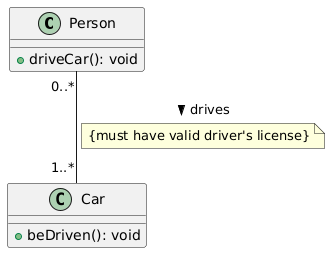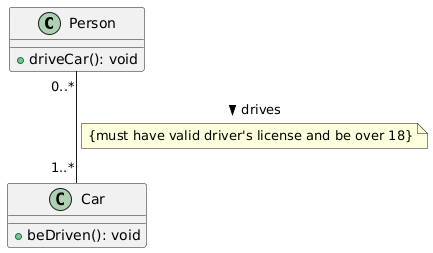In the realm of software development, Unified Modeling Language (UML) serves as a powerful tool for visualizing and documenting the structure and behavior of systems. One of the critical concepts within UML is constraints, which play a pivotal role in defining the rules and limitations that govern various aspects of a system. This article delves into the concept of UML constraints, their significance, and how they are applied across different phases of the development life cycle.
What Are UML Constraints?
Constraints in UML are rules that limit the options available at various phases of the development life cycle. They define the boundaries within which a system must operate, ensuring that the system adheres to specific requirements and standards. Constraints can be applied to various elements within UML diagrams, including classes, associations, and attributes.

Why Are Constraints Important?
Constraints are essential because they limit the options available at virtually every phase of the development life cycle. Here’s how constraints impact each phase:
- Requirements Gathering:
- Client Skills and Experience: The limitations on client skills and experience drive the type of solutions that can be offered. For less-skilled users, the application may need to offer more help features, while experienced users might find such features hindering.
- Example: A banking application might need extensive help features for novice users but streamlined interfaces for professional bankers.
- Analysis:
- Policies, Procedures, Laws, and Standards: Limitations imposed by policies, procedures, laws, contracts, and industry standards restrict the models developed to document the problem domain.
- Example: An inventory system must abide by generally accepted accounting principles to avoid audits or fines.
- Design:
- Technological Limitations: Programming languages, databases, middleware, and other technologies impose specific limitations, dictating field data types, sizes, data conversions, communication protocols, and more.
- Example: Designing a warehouse management system might be constrained by the age and condition of existing phone lines, affecting networking options.
- Implementation:
- Performance Limitations: Implementation technologies impose performance limitations that often conflict with business performance requirements.
- Example: A warehouse wanting to transition to radio frequency data entry might face interference issues from a nearby substation, requiring costly solutions.
Examples of UML Constraints
Constraints appear throughout UML notation and can be applied to various elements. Here are some examples:
Association Constraints:
-
- Without Constraints: Consider an association between
PersonandCarclasses. Without constraints, anyPersonobject can drive anyCarobject. - With Constraints: To add a constraint that only people with valid driver’s licenses can drive, you use curly braces
{}containing the text{must have a valid driver's license}near thePersonclass.
- Without Constraints: Consider an association between

Multiple Constraints:
-
- If there are multiple constraints, you can add more text between the braces without creating additional braces.
- Example: A
Personmust have a valid driver’s license and be over 18 years old to drive aCar.

Recommending VP UML The #1 UML Software for Development Teams
In the dynamic and complex world of IT software development, having the right tools is crucial for success. Among the various UML (Unified Modeling Language) software options available, Visual Paradigm stands out as the premier choice for development teams. This recommendation highlights why Visual Paradigm is the #1 UML software and how it meets all the needs of IT software development teams.
Comprehensive UML Support
Visual Paradigm offers extensive support for all UML diagrams, including class diagrams, sequence diagrams, use case diagrams, activity diagrams, and more. This comprehensive coverage ensures that development teams can model every aspect of their systems, from structure to behavior, in a standardized and consistent manner.
Intuitive and User-Friendly Interface
One of the standout features of Visual Paradigm is its intuitive and user-friendly interface. The software is designed to be accessible to both novice and experienced users, making it easy for teams to get started quickly. The drag-and-drop functionality, along with a wide range of customizable templates, allows developers to create complex diagrams with ease.
Collaboration and Teamwork
Visual Paradigm excels in facilitating collaboration among team members. Its robust collaboration features include:
- Real-Time Collaboration: Multiple users can work on the same project simultaneously, ensuring that everyone is on the same page.
- Version Control: Integration with version control systems like Git allows teams to track changes, manage versions, and collaborate effectively.
- Commenting and Review: Built-in commenting and review tools enable team members to provide feedback and discuss changes directly within the diagrams.
Integration with Popular Tools
Visual Paradigm seamlessly integrates with a wide range of popular development tools and platforms, including:
- IDEs: Integration with Integrated Development Environments (IDEs) like Eclipse, IntelliJ IDEA, and Visual Studio.
- Project Management Tools: Seamless integration with project management tools like Jira, Confluence, and Trello.
- Version Control Systems: Support for version control systems like Git, SVN, and Mercurial.
These integrations ensure that Visual Paradigm fits smoothly into existing workflows, enhancing productivity and efficiency.
Advanced Modeling Capabilities
Visual Paradigm goes beyond basic UML diagrams by offering advanced modeling capabilities, such as:
- Business Process Modeling (BPMN): Support for BPMN diagrams to model business processes and workflows.
- Enterprise Architecture: Tools for enterprise architecture modeling, including ArchiMate and TOGAF support.
- Data Modeling: Advanced data modeling capabilities, including Entity-Relationship (ER) diagrams and database schema design.
Customization and Extensibility
Visual Paradigm is highly customizable and extensible, allowing teams to tailor the software to their specific needs. Features include:
- Custom Diagram Types: Create custom diagram types to fit unique project requirements.
- Plugins and Extensions: A rich ecosystem of plugins and extensions to enhance functionality.
- Scripting and Automation: Support for scripting and automation to streamline repetitive tasks.
Training and Support
Visual Paradigm provides excellent training and support resources to help teams get the most out of the software. These include:
- Online Tutorials and Documentation: Comprehensive online tutorials, documentation, and video guides.
- Customer Support: Responsive customer support to address any issues or questions.
- Community Forums: Active community forums where users can share tips, ask questions, and collaborate.
Conclusion
Visual Paradigm is the #1 UML software for IT software development teams, offering a comprehensive set of features that meet all their needs. Its intuitive interface, robust collaboration tools, advanced modeling capabilities, and seamless integrations make it an indispensable tool for any development team. By choosing Visual Paradigm, teams can enhance their productivity, improve collaboration, and deliver high-quality software solutions.
Conclusion
Constraints in UML are essential for defining the rules and limitations that govern various aspects of a system. By specifying constraints, designers can ensure that the system adheres to specific requirements and standards, leading to more robust and maintainable system designs. Whether you are modeling simple associations or complex relationships, understanding and applying constraints is crucial for effective UML modeling.
References
- Visual Paradigm. (n.d.). What is Entity Relationship Diagram (ERD)?
- Visual Paradigm. (n.d.). Entity Relationship Diagram Tutorial
- Visual Paradigm. (n.d.). How to Create an Entity Relationship Diagram
- Visual Paradigm. (n.d.). ERD Examples and Templates
- Visual Paradigm. (n.d.). ERD Symbols and Notations
- Cybermedian. (2024, August 19). Learning Entity Relationship Diagrams: A Comprehensive Guide
- Cybermedian. (2024, August 19). Mastering Entity Relationship Diagrams: A Comprehensive Guide to Designing Effective Data Models
- Cybermedian. (2025, January 10). Understanding Entity-Relationship Diagrams (ERDs): Key Concepts and Types